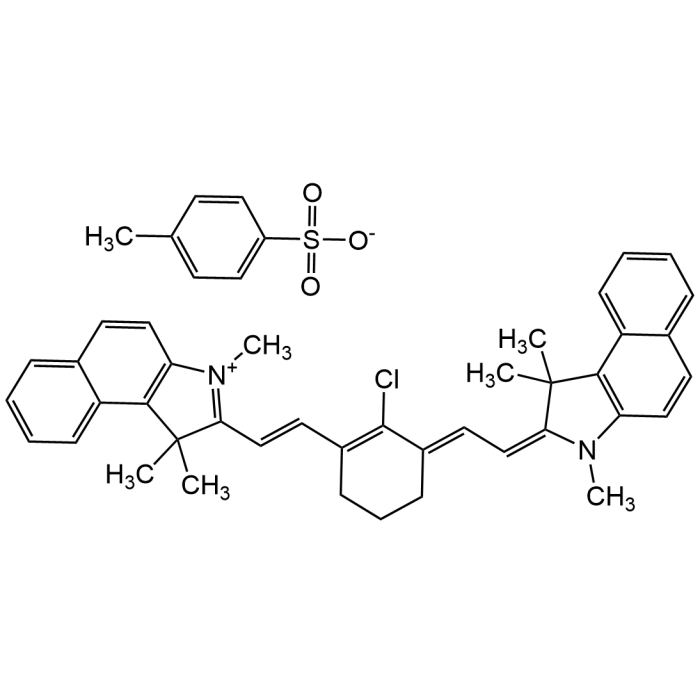Cookie Policy: This site uses cookies to improve your experience. You can find out more about our use of cookies in our Privacy Policy. By continuing to browse this site you agree to our use of cookies.
Chemodex
IR-813 p-toluenesulfonate

| Product Details | |
|---|---|
| Synonyms | Adagio; ADS 830A; IR 830; IR Dye 23b; NK-4680; Trump IR dye |
| Product Type | Chemical |
| Properties | |
| Formula | C47H47ClN2O3S |
| MW | 755.43 |
| CAS | 134127-48-3 |
| Source/Host Chemicals | Synthetic |
| Purity Chemicals | ≥98% (HPLC) |
| Appearance | Dark brown powder. |
| Solubility | Soluble in DMSO (20mg/ml) or methanol. |
| Declaration | Manufactured by Chemodex. |
| Other Product Data |
Click here for Original Manufacturer Product Datasheet |
| InChi Key | LQVQHHTYXSPHSQ-UHFFFAOYSA-M |
| Smiles | CC1=CC=C(S(=O)([O-])=O)C=C1.CC2(C)C(/C=C/C3=C(Cl)/C(CCC3)=C/C=C4C(C)(C)C5=C(C=CC6=CC=CC=C65)N\4C)=[N+](C)C7=C2C8=CC=CC=C8C=C7 |
| Shipping and Handling | |
| Shipping | AMBIENT |
| Short Term Storage | +4°C |
| Long Term Storage | -20°C |
| Handling Advice | Protect from light and moisture. |
| Use/Stability | Stable for at least 2 years after receipt when stored at -20°C. |
| Documents | |
| Product Specification Sheet | |
| Datasheet |
 Download PDF Download PDF |
IR-813 p-Toluenesulfonate is a functional near-infrared (NIR) cyanine laser dye. Spectral Data: λex=815nm, λem=840nm (MeOH). Used as a building block for the synthesis of fluorescent near-infrared (NIR) dyes. IR-813 has also been used to develop NIR organic light-emitting diodes (OLEDs) and as energy acceptor molecule in FRET experiments. It has been used for visualizing regional lymph nodes in mice or in non-invasive tumor imaging nanoparticles. IR-813 can be used as a probe in NIR spectroscopy due to its specific absorption and emission characteristics and makes it valuable in studying molecular interactions and dynamics. It is useful in medical and biological imaging because NIR light can penetrate biological tissues more deeply than visible light. It can be used in the development of optical sensors that detect specific wavelengths of light, which are then used to measure various parameters such as temperature, pH, or the presence of specific ions or molecules.
(1) C. Catry, et al.; Langmuir 15, 1364 (1999) | (2) Y. Xuan, et al.; Semicond. Sci. Technol. 22, 1021 (2007) | (3) Y. Xuan, et al.; Thin Solid Film 516, 7891 (2008) | (4) O. Kojima, et al.; J. Appl. Phys. 110, 083521 (2011) | (5) M. Helle, et al.; ACS Nano. 7, 8645 (2013) | (6) O. Kojima, et al.; J. Appl. Phys. 115, 083503 (2014) | (7) V. Launay, et al.; Adv. Funct. Mat. 31, 2006324 (2021) | (8) J.H. Yu, et al.; ACS Nano 15, 19956 (2021) | (9) A.R. Obah Kosso, et al.; Chem. Sci. 12, 6964 (2021)





